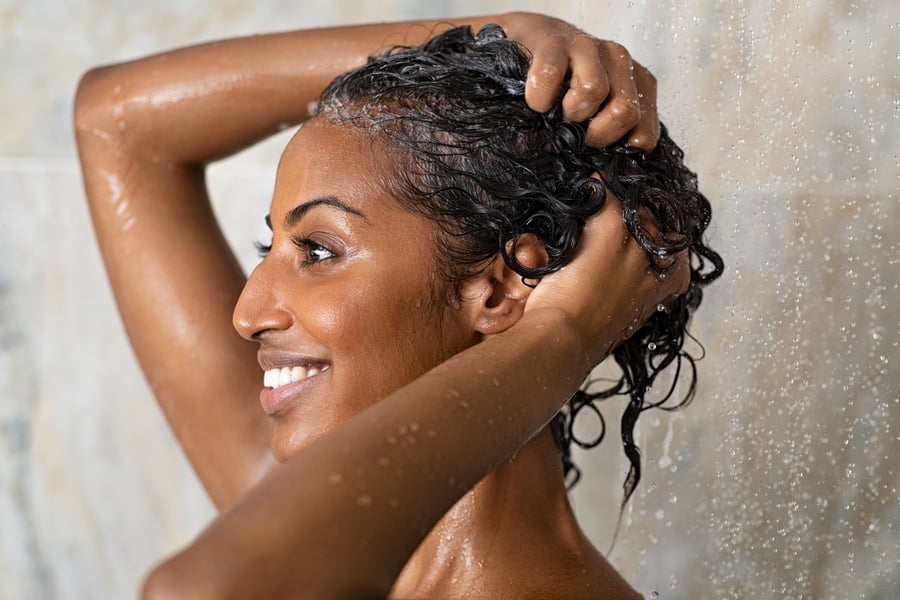
How Much Hair Is Normal to Lose in the Shower?
Have you ever wondered, “How much hair is normal to lose in the shower?” Worry not! In this blog post, we’ll explore the hair growth cycle, factors affecting hair loss, and tips to reduce hair shedding in the shower.
You’ll gain a better understanding of what’s normal and when it’s time to seek professional help.
Short Summary
-
Normal hair shedding is a natural part of the hair growth cycle and can be managed with gentle care.
-
Factors affecting in-shower loss include type, length, washing frequency, and practices.
-
To reduce shedding one should adopt gentle techniques, maintain nutrition/hydration levels & manage stress. Seek professional help if necessary.
Understanding Normal Hair Shedding

I LOVE MY HAIR NOW
FullyVital hair serum and hair vitamins made tremendous improvements in my hair. I truly love my hair now.
Meg S.,
Hair shedding is a natural part of the hair growth cycle. The average person loses 50-100 hairs daily, which is considered normal. The hair growth cycle consists of four phases:
-
Anagen (active growth)
-
Catagen (transition)
-
Telogen (resting)
-
Exogen (shedding)
It is essential to understand that hair loss is normal and some hair loss is completely normal, shedding varies depending on factors such as hair type, washing frequency, and hair care practices.
You can employ strategies to minimize hair falling, such as implementing gentle hair care practices, ensuring adequate nutrition and hydration, and managing stress.
Keep in mind that there are 80,000 to 150,000 hairs on a human head, so it will take a long time before you see scalp shining through.
By understanding the hair growth cycle and normal hair falling, you can take appropriate steps to maintain your hair’s health and reduce excessive hair loss.
Factors Affecting Hair Loss in the Shower
Several factors can affect hair loss in the shower, including your hair type, washing frequency, and hair care practices.
In the following subsections, we’ll delve deeper into these factors and how they contribute to shower hair loss.
Hair type is one of the most important factors in determining how much hair you lose.
Hair Type and Length
Hair type and length can play a role in how much hair you lose in the shower. Generally, long or thick hair may experience more shedding of strands. Hair types are categorized as:
-
Straight
-
Wavy
-
Curly
-
Coily/kinky
People with different hair types may notice varying amounts of hair shedding, especially when dealing with wet hair in the shower.
It’s important to recognize that hair shedding is a normal part of the hair growth cycle, and everyone’s experience may be different.
By understanding how hair type and length influence hair shedding, you can better assess whether the hair loss you’re experiencing in the shower is within the normal range.
Washing Frequency
The frequency at which you wash your hair can also impact hair loss in the shower. It’s common to observe an increase in hair shedding after longer intervals between washes.
This is because the hair that has already been shed and is not in the growth phase gets eliminated during washing.
So, if you notice more hair coming out in the shower after not washing your hair for a few days, don’t panic.
It’s totally normal and not indicative of a hair loss problem. Remember, hair shedding is a completely normal part of the hair growth cycle.
Hair Care Practices
Your hair care practices can also contribute to hair loss in the shower.
Using harsh products or heat styling can be detrimental to your hair health, leading to more hair breakage and shedding.
Chemical treatments and hair dyes containing bleach can make hair brittle and prone to breakage, resulting in heightened hair loss.
Additionally, washing your hair in water that is too hot may cause damage to the hair strands.
Using an inappropriate brush or comb can also contribute to hair loss in the shower.
To avoid hair loss, opt for gentle hair care practices, such as using a wide-tooth comb and avoiding harsh products.
By adopting appropriate hair care techniques, you can minimize hair shedding and maintain your hair’s strength and vitality.
Identifying Excessive Hair Loss
It’s crucial to identify when hair shedding crosses the line from normal hair loss to excessive.
Generally, losing more than 100 hairs per day is considered excessive hair loss.
One might wonder, how much hair loss is normal? Signs of excessive hair loss include:
-
Evidence of in-shower hair shedding
-
Thinning hair
-
Receding hairline
-
Bald patches
-
Hair coming out in clumps
Excessive hair loss may be indicative of more permanently thinning hair, such as pattern balding or hair falling.
If you’re losing more than 100 hairs a day when washing your hair, it’s a cause for concern. Seek professional advice to assess the severity of the issue.
Addressing excessive hair loss is essential for maintaining your hair’s health and addressing any underlying issues that might be causing it.
Causes of Excessive Hair Loss
Excessive hair loss can result from various factors, including:
-
Medical conditions such as thyroid issues and diabetes
-
Medications, including acne treatments containing vitamin A (retinoids), antifungal medications, and some antibiotics
-
Stress
-
Genetics
Stress levels, genetics, and environmental factors can induce hair follicles to enter the shedding phase more quickly than is typical for the individual, leading to excessive hair loss.
One such condition is telogen effluvium, which occurs when hair enters the resting stage, resulting in daily shedding without new hair growth.
While a small amount of hair loss is normal, it’s crucial to identify the root cause of excessive hair loss to address the issue effectively.
If you suspect that a medical condition, medication, or stress is contributing to your hair loss, consult a healthcare professional to discuss the best course of action.
Tips for Reducing Hair Shedding in the Shower
By implementing gentle hair care techniques, following a nutritious diet, and managing stress levels, you can reduce hair shedding in the shower.
In the following subsections, we’ll provide more detailed tips to help you minimize hair loss and maintain your hair’s health.
Gentle Hair Care Techniques
Gentle hair care techniques can help reduce hair shedding in the shower. Use a wide-tooth comb to detangle your hair, especially when it’s wet, as this can minimize hair breakage.
Avoid using harsh products, such as hair dyes, bleaches, and chemical shampoos, which can weaken the hair and make it brittle, leading to strands breaking off and a decrease in hair volume.
Additionally, avoid tight hairstyles and rubber hair elastics, which can cause hair breakage.
Opt for hair ties made from silk or soft cotton, which are gentler on your hair. By incorporating these gentle hair care techniques, you can reduce hair shedding in the shower and maintain healthier hair.
Proper Nutrition and Hydration
Proper nutrition and hydration play a vital role in maintaining healthy hair and preventing excessive hair loss.
Consuming a balanced diet rich in essential nutrients such as iron, protein, zinc, omega-3 fatty acids, and biotin can support hair growth and overall hair health.
Avocados, red meat, sweet potatoes, sweet peppers, berries, nuts, fish, and eggs are great sources of nutrition for promoting hair growth.
Regular consumption of these foods can help to strengthen hair naturally.
In addition to a healthy diet, staying hydrated is crucial for hair health.
Drinking enough water throughout the day can help prevent hair from becoming dry and brittle, reducing the chances of hair shedding in the shower.
Stress Management
Managing stress is another essential aspect of reducing hair shedding in the shower.
High stress levels can negatively impact hair health and contribute to conditions like telogen effluvium.
To manage stress, engage in self-care activities, regular exercise, and ensure you’re getting enough sleep.
Incorporating relaxation techniques such as yoga, meditation, or deep breathing exercises can also help reduce stress and promote overall well-being.
By effectively managing stress, you can not only improve your hair health, but also enhance your overall quality of life.
Seeking Professional Help
If you’ve implemented the tips mentioned above and still experience excessive hair loss, it’s important to seek professional help.
Consult a doctor or trichologist to discuss potential solutions and identify the underlying cause of your hair loss and the health of hair follicles.
Your general practitioner can suggest treatments and provide support if hair loss is impacting your mental health.
Non-surgical treatments may be available if the issue is identified in its early stages.
Therefore, it’s essential to schedule a consultation with a hair loss expert to discuss a treatment plan if permanent hair loss is a concern.
Remember, the sooner you address the issue, the better your chances are of finding an effective solution.
Summary
In conclusion, understanding normal hair shedding, the factors affecting hair loss in the shower, and implementing effective strategies to reduce hair shedding can help you maintain healthy hair.
Remember that some hair loss is normal, and if you suspect excessive hair loss, seek professional help to address any underlying issues.
By taking a proactive approach to hair care, you can enjoy luscious locks and prevent excessive hair loss in the shower.
Frequently Asked Questions
Why am I losing so much hair in the shower?
Showering can cause additional hair loss due to manipulating the hairs that have already shed and stimulating the scalp when shampooing or conditioning.
Therefore, it is common to experience extra shedding in the shower.
How much hair loss after shower is normal?
It is normal to lose between 50 to 100 hairs a day; however, people with longer or thicker hair can experience more shedding after a shower, up to 200 hairs.
Read our article on normal hair part vs thinning to get a good idea of the progression of your hair loss.
What factors affect hair loss in the shower?
Hair type, washing frequency, and hair care practices can all play a role in the amount of hair loss experienced in the shower.
These factors can affect how much hair is lost during a shower, and how often it needs to be replaced.
Different hair types require different care, and the frequency of washing can also have an impact. Taking the time to take the time to learn.
How can I reduce hair shedding in the shower?
To reduce hair shedding, practice gentle hair care techniques, maintain a balanced diet and manage stress.
When should I seek professional help for hair loss in the shower?
If you are experiencing excessive hair loss, it is advised to seek professional help from a doctor or trichologist as soon as possible.
The question of how much hair loss is normal can be different depending on the individual and their hair growth phase.







